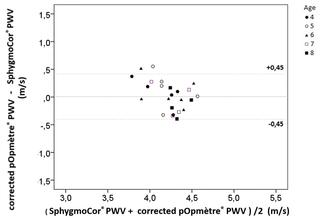PLOS ONE ( IF 3.7 ) Pub Date : 2020-03-27 , DOI: 10.1371/journal.pone.0230817 Saïd Bichali 1 , Alexandra Bruel 2 , Marion Boivin 3 , Gwénaëlle Roussey 2 , Bénédicte Romefort 1 , Jean-Christophe Rozé 4 , Emma Allain-Launay 2

|
In population exposed to cardiovascular risk, aortic stiffness is an important marker which is assessed by carotid-to-femoral pulse wave velocity (PWV). In childhood, the validated applanation tonometer SphygmoCor® can be used to measure PWV, but is limited in routine practice by the child’s cooperation and operator’s experience. An alternative device, the pOpmètre® is validated in adults and rapidly measures finger-to-toe PWV using 2 oxymeter-like sensors. The aim of this study is to validate the pOpmètre® device in children aged between 4 and 8 years. We compared simultaneous PWV measurements of the two devices, SphygmoCor® and pOpmètre®, in a training group, using the Bland-Altman method. Then we proposed an algorithm to correct pOpmètre® PWV (PWVpop). Finally, we validated this new algorithm in a validation group of children using the Bland-Altman method. This prospective study enrolled 26 children in the training group. Mean PWVpop was 3.919 ± 0.587 m/s and mean SphygmoCor® PWV was 4.280 ± 0.383 m/s, with a difference of -0.362(CI95%(-0.546;-0.178)) m/s. A new algorithm was defined using transit time (TTpop): corrected PWVpop (m/s) = 0.150/TTpop(s) + 1.381*Height(m) + 1.148. We enrolled 24 children in the validation group. Mean corrected PWVpop was 4.231 ± 0.189 m/s and mean SphygmoCor® PWV was 4.208 ± 0.296 m/s with a corrected difference of 0.023(CI95%(-0.086;0.131)) m/s. With this algorithm correction, we found an agreement between PWV measured by the SphygmoCor® and the pOpmètre®, with a difference of less than 10%. Using this algorithm, the pOpmètre® could be used in clinical or research practice in young children exposed to cardiovascular risk. (This study was registered as NCT02991703).
中文翻译:

儿童简化的脉搏波速度测量:pOpmètre有效吗?
在有心血管风险的人群中,主动脉僵硬度是一个重要的指标,可通过颈动脉到股动脉脉搏波速度(PWV)进行评估。在儿童期,经验证的压平眼压计SphygmoCor®可用于测量PWV,但由于儿童的配合和操作者的经验,在常规实践中受到了限制。另一种设备pOpmètre®已在成人中验证,并使用2个类似血氧计的传感器快速测量手指到脚趾的PWV。这项研究的目的是验证4至8岁儿童中的pOpmètre®设备。我们在一个训练小组中使用Bland-Altman方法比较了SphygmoCor®和pOpmètre®这两种设备的同时PWV测量。然后,我们提出了一种校正pOpmètre®PWV(PWVpop)的算法。最后,我们使用Bland-Altman方法在一组验证儿童中验证了该新算法。这项前瞻性研究招募了26名儿童参加训练。平均PWVpop为3.919±0.587 m / s,平均SphygmoCor®PWV为4.280±0.383 m / s,差异为-0.362(CI95%(-0.546; -0.178))m / s。使用渡越时间(TTpop)定义了一种新算法:校正后的PWVpop(m / s)= 0.150 / TTpop(s)+ 1.381 * Height(m)+ 1.148。我们在验证组中招募了24名儿童。平均校正后的PWVpop为4.231±0.189 m / s,平均SphygmoCor®PWV为4.208±0.296 m / s,校正差为0.023(CI95%(-0.086; 0.131))m / s。通过这种算法校正,我们发现SphygmoCor®和pOpmètre®测得的PWV之间的一致性小于10%。使用此算法,pOpmètre®可用于患有心血管疾病的幼儿的临床或研究实践中。(该研究注册为NCT02991703)。


























 京公网安备 11010802027423号
京公网安备 11010802027423号